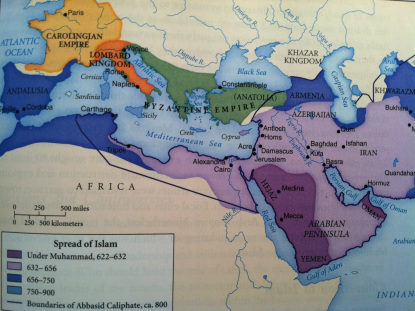The Basic Gist
Srivi Vishnubhotla & Yazmin Gooren
3.1.3:
Describe the origins, belief system/values and expansion of Islam through Afro-Eurasia. Case study must focus on the expansion of either the Ummyad or Abbasid dynasties.
The sole originator prophet of Islam was Muhammad Ibn Abdullah, who was alive from roughly 570 to 632 CE. Growing up in Mecca, he was exposed to Judaism, Christianity, and various polytheistic faith, and though initially a successful merchant, he eventually , like many prophets before him, felt the need to withdraw from society and look for answers in meditation. Eventually, this led to the development of Islam, based on the utter submission to God, or Allah, and the creation of ummah, a nation of Islam. The core values delineating the Islamic belief system are summarized by the Five Pillars, which are defined in the Quran, the holy Islamic text (Doc. 11.1). These consist of the following:
1. Shahada – belief that Allah is the only god and that Muhammad is
the final prophet.
“There is no god but Allah and Muhammad is His
prophet.”
2. Salat – prayer five times a day at early morning, noon,
mid-afternoon, sunset, and evening.
3. Zakat – charity and generosity.
4. Sawm – fasting during the month of Ramadan.
5. Hajj –pilgrimage to Mecca.
In addition to these five pillars, Islamic people also believe that Allah is beyond imagination and as a result it is heretical to try to imagine or illustrate him. Another essential component not included in the Pillars is the concept of the "jihad," or struggle. In the western world, the concept of jihad is misunderstood and generally thought of a violent, militant struggle against those unwilling to worship Allah. This is known as the “lesser jihad of the sword” and is much less important than the “greater jihad”, which is internal spiritual striving. The concept of “greater jihad” is a principle shared by most religious systems, as the perpetuation of personal faith in order to convert others and thereby gain followers is a common religious goal within society.
After the death of Muhammad, Islam spread very rapidly through Eurasia due to the weakened Byzantine and Persian empires. Islamic people were able to take advantage of this weakness and flourish throughout Eurasia, first under the Umayyad (which expanded the Islamic Empire into northern Africa and Spain) and then the Abbasid Dynasty (which lost Spain but spawned an Islamic golden age). Many additional factors also influenced this spread. For one, economic gain was a major galvanizing force, because the capture of select trade routes and agricultural regions was desired in order to create strong economic roots. Trade was facilitated by the usage of trade abd a system of "itemized receipts and bills," and Islam was allowed to spread along these trade routes, As a result, many small merchant towns within otherwise non-Islamic regions developed, which then gained more people and spread. Along with that, there were also various individual Arabs who sought personal advancement. They often perpetuated the spread of ummah, the Islamic understanding of an Islamic nation or community. This also led to the emergance of a new question: who exactly is allowed to succeed Muhammad as the main Islam's core military, political, social, and religious leader? Many were seeking to become caliphates, or destined rulers, of cities. After Muhammad’s death, the appointment of caliphates became an issue which permanently divided Islam into two sects: the Sunni and the Shia. Sunni Muslims believe that caliphs should be the most pious followers of Allah, elected from a pool of eligible applicants. Shia Muslims, on the other hand, believe that the role of caliph should be given exclusively to those who bear blood relation to Muhammad. Within cities religious tolerance was practiced until the 8th century, at which points Islam began seeking converts. Christians, Jews, and Zoroastrians were still allowed to practice their respective religions, though they were forced to pay a special tax (called “jizya”) in order to "earn" the right to be able to do so, with the goal in mind being that a common faith would be beneficial for the empire. People who practiced these religions were called “dhimmis” or “people of the book.” Polytheistic religions and theistic spiritual philosophies were scorned and people who studied them were often encouraged or forced to convert to Islam, though other customs were tolerated and even absorbed, contributing to the spread of Islam through Afro-Eurasia.
Describe the origins, belief system/values and expansion of Islam through Afro-Eurasia. Case study must focus on the expansion of either the Ummyad or Abbasid dynasties.
The sole originator prophet of Islam was Muhammad Ibn Abdullah, who was alive from roughly 570 to 632 CE. Growing up in Mecca, he was exposed to Judaism, Christianity, and various polytheistic faith, and though initially a successful merchant, he eventually , like many prophets before him, felt the need to withdraw from society and look for answers in meditation. Eventually, this led to the development of Islam, based on the utter submission to God, or Allah, and the creation of ummah, a nation of Islam. The core values delineating the Islamic belief system are summarized by the Five Pillars, which are defined in the Quran, the holy Islamic text (Doc. 11.1). These consist of the following:
1. Shahada – belief that Allah is the only god and that Muhammad is
the final prophet.
“There is no god but Allah and Muhammad is His
prophet.”
2. Salat – prayer five times a day at early morning, noon,
mid-afternoon, sunset, and evening.
3. Zakat – charity and generosity.
4. Sawm – fasting during the month of Ramadan.
5. Hajj –pilgrimage to Mecca.
In addition to these five pillars, Islamic people also believe that Allah is beyond imagination and as a result it is heretical to try to imagine or illustrate him. Another essential component not included in the Pillars is the concept of the "jihad," or struggle. In the western world, the concept of jihad is misunderstood and generally thought of a violent, militant struggle against those unwilling to worship Allah. This is known as the “lesser jihad of the sword” and is much less important than the “greater jihad”, which is internal spiritual striving. The concept of “greater jihad” is a principle shared by most religious systems, as the perpetuation of personal faith in order to convert others and thereby gain followers is a common religious goal within society.
After the death of Muhammad, Islam spread very rapidly through Eurasia due to the weakened Byzantine and Persian empires. Islamic people were able to take advantage of this weakness and flourish throughout Eurasia, first under the Umayyad (which expanded the Islamic Empire into northern Africa and Spain) and then the Abbasid Dynasty (which lost Spain but spawned an Islamic golden age). Many additional factors also influenced this spread. For one, economic gain was a major galvanizing force, because the capture of select trade routes and agricultural regions was desired in order to create strong economic roots. Trade was facilitated by the usage of trade abd a system of "itemized receipts and bills," and Islam was allowed to spread along these trade routes, As a result, many small merchant towns within otherwise non-Islamic regions developed, which then gained more people and spread. Along with that, there were also various individual Arabs who sought personal advancement. They often perpetuated the spread of ummah, the Islamic understanding of an Islamic nation or community. This also led to the emergance of a new question: who exactly is allowed to succeed Muhammad as the main Islam's core military, political, social, and religious leader? Many were seeking to become caliphates, or destined rulers, of cities. After Muhammad’s death, the appointment of caliphates became an issue which permanently divided Islam into two sects: the Sunni and the Shia. Sunni Muslims believe that caliphs should be the most pious followers of Allah, elected from a pool of eligible applicants. Shia Muslims, on the other hand, believe that the role of caliph should be given exclusively to those who bear blood relation to Muhammad. Within cities religious tolerance was practiced until the 8th century, at which points Islam began seeking converts. Christians, Jews, and Zoroastrians were still allowed to practice their respective religions, though they were forced to pay a special tax (called “jizya”) in order to "earn" the right to be able to do so, with the goal in mind being that a common faith would be beneficial for the empire. People who practiced these religions were called “dhimmis” or “people of the book.” Polytheistic religions and theistic spiritual philosophies were scorned and people who studied them were often encouraged or forced to convert to Islam, though other customs were tolerated and even absorbed, contributing to the spread of Islam through Afro-Eurasia.
The map on the left shows the extent to which Islam had spread through Afro-Eurasia from about 622 to until about 900 CE, while the one on the right shows the continuation of that expansion after that particular point in time. The difference between these two maps is striking, especially when examining the manner in which the expansion of Islam was accompanied by the extension of long-distance trade routes. This provides evidence for the notion that the spread of Islam was, in essence, a mere side-effect of the Arab wish for economic growth and gain.
Works Cited
Armstrong, Monty, David Daniel, Abby Kanarek, and Alexandra Freer. "Chapter 7; Really Old Stuff: Around 600 CE to Around 1450" Cracking the AP:
World History Exam 2013. 2013 ed. New York: Random House, 2012. 134-138. Print. The Princeton Review.
Muhammad (prophet). N.d. Photograph. Wikipedia. Wikimedia Foundation. Web. 18 Dec. 2012.
Open Quran. N.d. Photograph. Muslim Voices. Muslim Voices Organization. Web. 20 Dec. 2012.
Strayer, Robert W. "Chapter 11: The Worlds of Islam." Ways of the World: A Brief Global History with Sources. Boston, MA: Bedford/St. Martins, 2011. N. pag. Print.
Strayer, Robert W. "Document 11.1; The Voice of Allah: The Quran." Ways of the World: A Brief Global History with Sources. Boston, MA.
Bedford/St.Martins, 2011. N. pag. Print.
Strayer, Robert W. "The Arab Empire and the Initial Expansion of Islam, 622-900 CE." Map. Ways of the World: A Global History with Sources. Boston, MA:
Bedford/St. Martins, 2011. N. pag. Print.
Strayer, Robert W. "The Growing World of Islam, (900-1500)." Map. Ways of the World: A Global History with Sources. Boston, MA:
Bedford/St. Martins, 2011. N. pag. Print.
"The Worlds of Islam: Afro-Eurasian Connections, 600-1500 : Chapter Outline." Ways of the World: A Brief Global History. N.p., n.d. Web. 18 Dec.
2012.
World History Exam 2013. 2013 ed. New York: Random House, 2012. 134-138. Print. The Princeton Review.
Muhammad (prophet). N.d. Photograph. Wikipedia. Wikimedia Foundation. Web. 18 Dec. 2012.
Open Quran. N.d. Photograph. Muslim Voices. Muslim Voices Organization. Web. 20 Dec. 2012.
Strayer, Robert W. "Chapter 11: The Worlds of Islam." Ways of the World: A Brief Global History with Sources. Boston, MA: Bedford/St. Martins, 2011. N. pag. Print.
Strayer, Robert W. "Document 11.1; The Voice of Allah: The Quran." Ways of the World: A Brief Global History with Sources. Boston, MA.
Bedford/St.Martins, 2011. N. pag. Print.
Strayer, Robert W. "The Arab Empire and the Initial Expansion of Islam, 622-900 CE." Map. Ways of the World: A Global History with Sources. Boston, MA:
Bedford/St. Martins, 2011. N. pag. Print.
Strayer, Robert W. "The Growing World of Islam, (900-1500)." Map. Ways of the World: A Global History with Sources. Boston, MA:
Bedford/St. Martins, 2011. N. pag. Print.
"The Worlds of Islam: Afro-Eurasian Connections, 600-1500 : Chapter Outline." Ways of the World: A Brief Global History. N.p., n.d. Web. 18 Dec.
2012.




